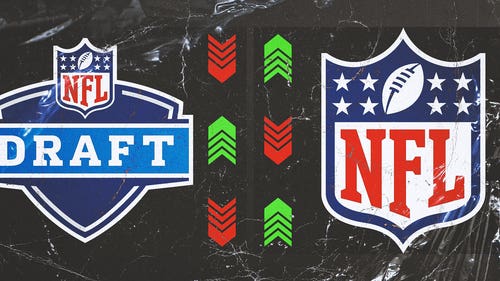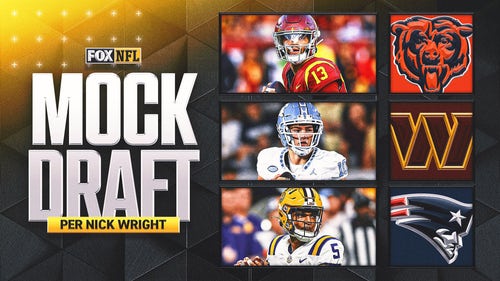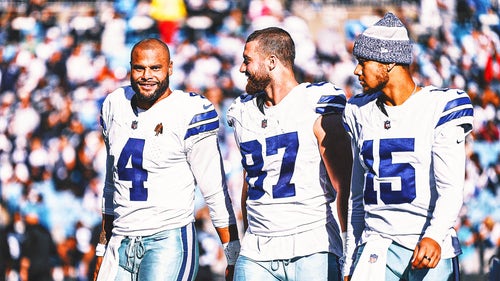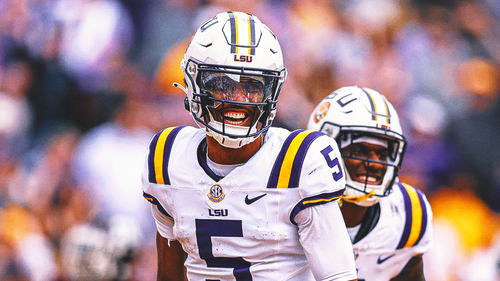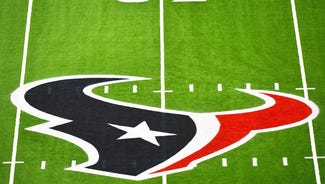
Wideouts wearing out their welcome

By Joe Oberle
The best wide receivers in the NFL move fast. They race past defenders and make acrobatic leaps for touchdown passes, creating some of the most exciting plays in the history of the game. But on their way to the end zone, some receivers have veered off course a bit. Some talented NFL wide receivers have quickly become well-traveled wideouts, moving from team-to-team so often they are destined to fade into the sunset rather than go out in a blaze of glory.
The trend continues this offseason.
The Buffalo Bills recently signed wide receiver Percy Harvin, making it Harvin’s fourth team in four years. He joins a pair of other big-name, high-maintenance receivers who can’t seem to put down roots very long. Brandon Marshall was traded to the Jets this spring and will play for his fourth team in a 10-year career, and former Dolphin Mike Wallace is on to Minnesota, which will be his third team in seven seasons.
What is it about the position of wide receiver that generates such peripatetic legacies for the athletes who play it? Does the position engender an attitude of dissatisfaction or does the general attitude of the players who become wideouts make them unfulfilled employees and recalcitrant wanderers?
There is certainly a history of itinerant wide receivers. The movement of Harvin, in particular, brings to mind some other problem-child wideouts who also made the rounds: Terrell Owens and Randy Moss both played for five teams (although Moss played for the Vikings twice). But for every Moss or Owens, who made as much news outside of their uniform as in it, there are plenty of other receivers who simply line up, toe the line and run their pass patterns—so it’s not fair to say that only malcontents play wide receiver.
A good number of great receivers do migrate from one team to another, though.
Of the top 10 receivers (in yardage) in NFL history, only two—Marvin Harrison and Reggie Wayne—played for just one team (although if Wayne doesn’t retire this offseason and plays with another team, it will become only Harrison).
Looking further into the top 20 receivers in yardage, you add only one more homebody—Steve Largent, who spent his 14-year career in Seattle. Some of the wide receiver movement is brought about by players becoming free agents in search of bigger contracts while others are trying to extend their careers at all costs—for stats and legacy (Jerry Rice—three teams) or perhaps for a chance at a ring (Cris Carter—three teams).
But for some of these current receivers, such as Harvin, Marshall, and Wallace, it appears to be more about attitude. They are productive, even explosive, but the headaches they cause are not worth keeping them on the roster.
Harvin played himself out of Minnesota (by throwing a weight at his head coach), was traded away from a championship team in Seattle (not long after throwing a punch at a teammate), spent half a season with the New York Jets, and is now in Buffalo. He is being reunited with former Jets coach Rex Ryan there, but someone new will be signing his checks.
Marshall had a career on the rise in Denver until problems arose. He became disgruntled over a team doctor’s mis-diagnosis of a hip injury, didn’t like his contract, was suspended for “throwing a tantrum” in practice and was ultimately traded to the Dolphins.
He lasted just two seasons in Miami (even though he made the Pro Bowl in his last year there) and he moved on to Chicago, where he became a first-team All-Pro in his first season. In year three in Chicago, he had a post-game tirade in front of the media, which may have begun to seal his offseason fate. Perhaps the Jets think anything is an improvement over Harvin’s attitude.
Meanwhile, Wallace is now a Viking after Miami apparently had enough of his act. He had come to the Dolphins in 2013 from the Steelers as a free agent (it’s worth noting that Minnesota tried to sign him then). In the final game of the 2014 season, Wallace spent the second half on the bench, and that didn’t sit well with at least one of his teammates. Wallace often didn’t see eye to eye with his coach, and the team sent him (plus a seventh-round pick) packing for a fifth-rounder from Minnesota. Not a lot for someone considered the fastest wideout in the league.
So it’s true that some wideouts have issues, but why? The position and its demands are at the root of the discontent. Wide receiver is a frustrating position to play.
It can be a lot of work for little payoff—they run plenty of wind sprints (deep routes) that lead right out of camera range. When a running back’s number is called, he’s getting the rock and has an opportunity to make a play. A wide receiver might run the length of the field and not be able to catch a pass. He might have run a great route, beat his defender (even double coverage) and is running free to the end zone and still might come up empty handed.
There are many variables involved in a wide receiver catching a pass. The line has to give the quarterback time, the quarterback has to believe the wideout is going to get open, and he has to throw a catchable pass—preferably in stride. Only then does the receiver have a chance to make a play amid encroaching defenders.
But only if the quarterback throws the ball to that particular wideout. There are often five potential receivers in on a pass play (sometimes six if you are the New England Patriots, but one is just an ineligible decoy), and the quarterback might not have time to see the wide receiver streaking open up the sidelines and he dumps it off underneath to the fullback, who rumbles ahead for three yards, finishing short of the first down.
The wide receiver ran a great route, and the team is pleased that it opened things up underneath for the short gain. That’s part of his job, but it’s easy to see how a wide receiver can get frustrated. Not because he had to run all that way, but because his skills are being underutilized.
In a typical game, if a wide receiver gets 10 targets that is considered a very busy night. The top two receivers in the league last season—Antonio Brown and Demaryius Thomas—had 178 targets, which amounts to 11.1 per game. The third most belonged to Julio Jones with 156 targets in 15 games (10.6 per game) and the rate and frequency begin to drop off after that.
Brown caught 129 passes for an 8.06 per game average. His 11.1 targets per game in a Pittsburgh offense that ran an average of 67.1 offensive plays per game made up 16 percent of the offense. Not bad. But when you compare him to his teammate, running back Le’Veon Bell, it starts to pale.
Bell rushed 289 times in 2014 and was targeted 100 times in the passing game. That’s an average of 24.3 opportunities per game to make a play—more than double Brown’s opportunities. And that could rankle a receiver come contract negotiation time.
In fact, Marshall, who came to Chicago three seasons ago and reunited with his old Denver quarterback Jay Cutler, was supposed to be a No. 1 receiver. But with the emergence of wideout Alshon Jeffery (135 targets, 85 receptions and 10 touchdowns) and the riding of workhorse running back Matt Forte (118 targets, 266 rushes for 394 opportunities to make a play), Marshall’s 101 targets, 61 receptions, and eight touchdowns (in 13 games) drops him down in the Bears offensive pecking order. Marshall saw a lot of double teams, which contributed to the lower production, but his numbers ultimately made him moveable, and his squawking about the Bears offense likely made it an easy decision.
A wide receiver needs receptions and touchdowns to get paid in the NFL, and you don’t get receptions and touchdowns unless they throw you the ball. Downfield blocking is often required and certainly valued at the position, but being a decoy is not the kind of thing that usually results in multi-million dollar signing bonuses.
Wide receivers as a group aren’t often known as grinders. They are acrobatic and fast and operate with finesse and skill more than power and strength. At its basic level, football is a game of power, strength, and hitting. Great running backs look for hits; linemen and defenders know it’s just a part of every play. And wideouts like to run past people, avoid getting drilled and make highlight-reel plays. This doesn’t make them lesser football players, it’s just when the speed and athletic skill goes, the player becomes expendable and replaceable.
Fans love the flash of wide receivers, but championships are still won with grit and teamwork. So it’s best not to make waves if you are a wideout. Harvin, Marshall, and Wallace have yet to completely learn that you should do your job rather than complain about not being able to do your job.
When you look at this trio’s histories in the league thus far, their brilliance is obvious, but wearing out your welcome and hiking off to the next stop is not going to engender love, money and accolades in the long run. Wide receivers have historically struggled to get into the Hall of Fame—there are 46 halfbacks and fullbacks combined compared to 26 wide receivers (in the modern day sense of the position, excluding tight ends and two-way players back in the day).
Moss and Owens will get there (they are ranked in the top three all time in reception yards and receiving touchdowns), but they’re probably going to have to wait a while. Rice was a first ballot Hall of Famer, but Carter was a six-time finalist before he got in and was beginning to wonder if it would ever happen. Andre Reed, who is 14th on the all time list for receiving touchdowns finally got in the Hall, but No. 18 Andre Rison, who played for seven different teams, doesn’t stand a chance.
Then again, maybe the Hall of Fame isn’t what the modern day wide receiver is looking for? Certainly it isn’t top of mind during the peak of any NFL player’s career. Wins, titles, and money usually take precedence, and if you get enough wins and titles and the Hall enshrinement should take care of itself.
But Keyshawn Johnson (34th on the all-time reception yardage list and a veteran of four teams in 11 seasons) famously said, “Just give me the damn ball!” And his book emblazoned with that title will likely be the peak of his legacy. So, maybe that represents a cautionary tale for this trio of team travelers: settle down, settle in, and try to help your team win a championship. Harvin has a ring that he won with Seattle, but he doesn’t have a clue how to be a good teammate.
In the end, perhaps it’s a lunch pail mentality—playing 14 years in one place like Largent—that leads to contentment at the wide receiver position. It led Largent to the Pro Football Hall of Fame—and even a job in the U.S. House of Representatives after his playing days. I’m not sure Harvin is on the career track for holding pubic office just yet.
More from The Sports Post:








































































































































